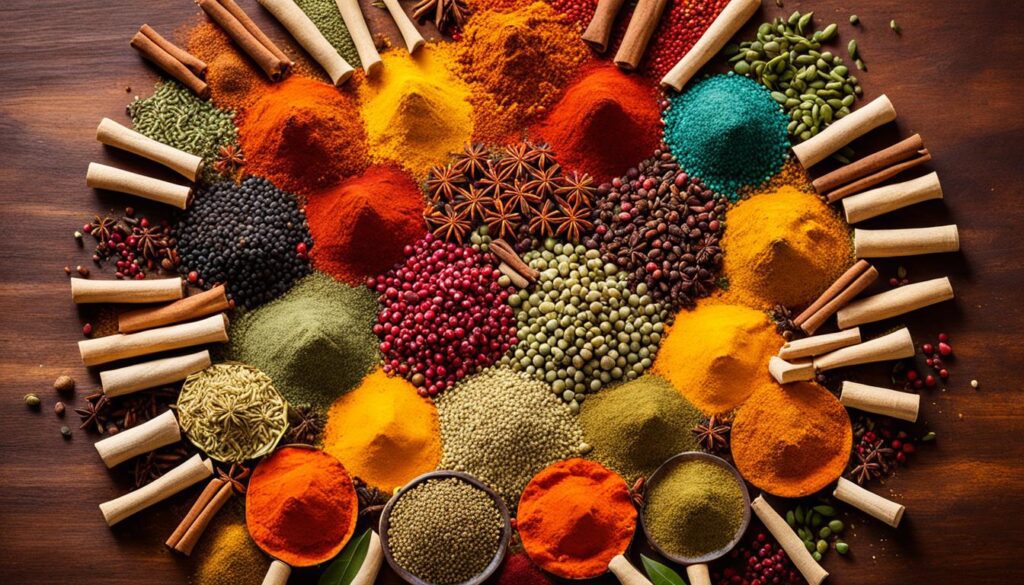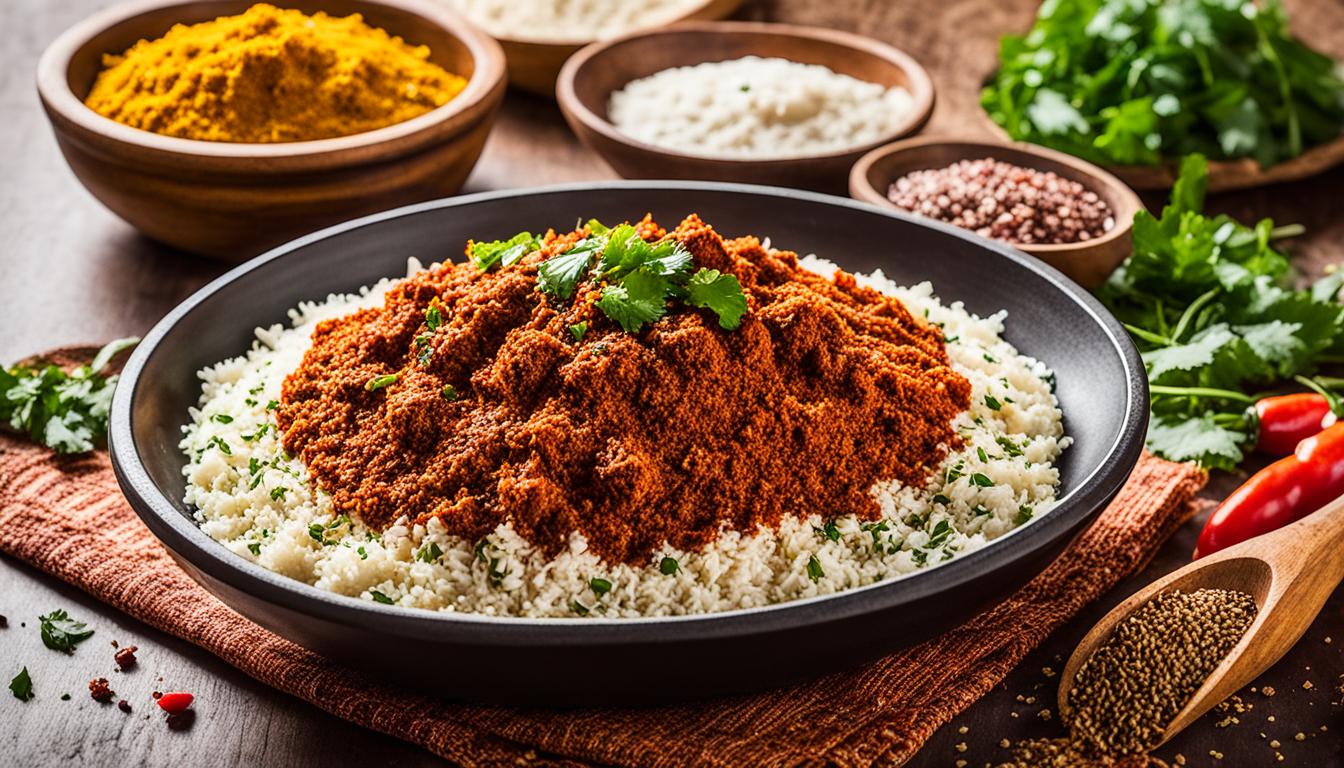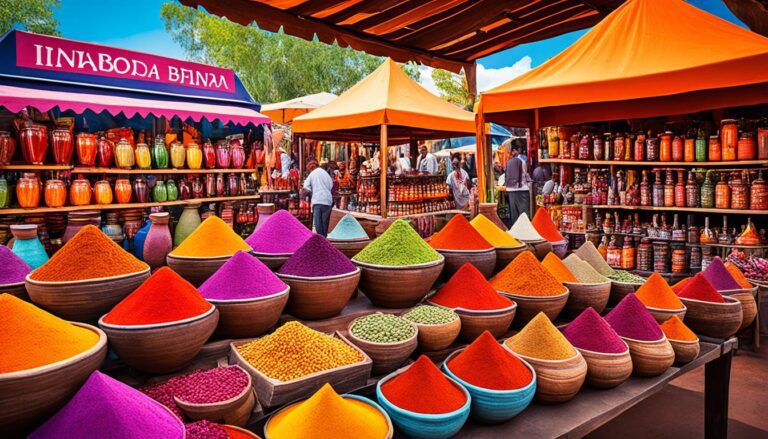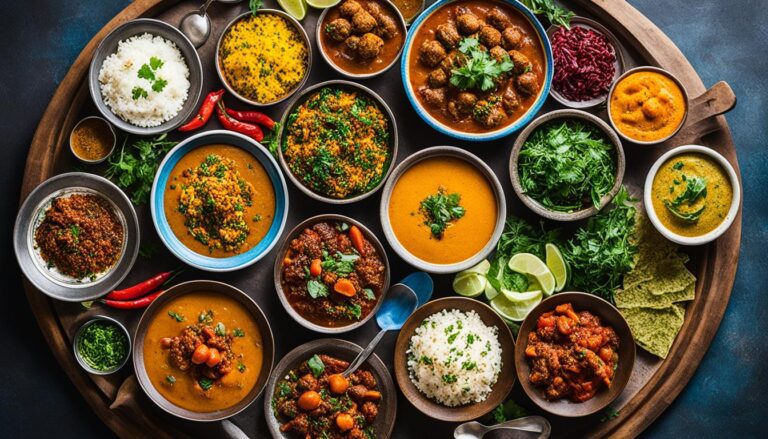What Is Kimisha Ethiopian Food?
Have you ever tasted the flavors of Kimisha Ethiopian food? This unique culinary experience takes you on a journey through the vibrant and rich Ethiopian and Eritrean cuisines. From the tangy injera bread to the flavorful wat stews and aromatic spices, Kimisha Ethiopian food offers a feast for the senses. But what exactly is Kimisha Ethiopian food, and what makes it so special? Let’s explore the fascinating world of Ethiopian and Eritrean cuisine and discover the hidden delights of this tantalizing meal.
Key Takeaways:
- Kimisha Ethiopian food is a traditional meal of Ethiopian and Eritrean cuisine.
- It consists of injera bread topped with various wat stews.
- Eating Kimisha Ethiopian food is a communal experience.
- Ethiopian and Eritrean cuisines are known for their rich flavors and use of spices.
- Explore the culinary delights of Kimisha Ethiopian food and immerse yourself in the vibrant flavors of Africa.
The Variety of Ethiopian and Eritrean Dishes and Foods
Ethiopian and Eritrean cuisines offer a wide variety of dishes and foods that will tantalize your taste buds. Let’s explore some of the mouthwatering options you can indulge in.
Injera: A Staple of Ethiopian and Eritrean Cuisine
One of the most iconic dishes you’ll find in Ethiopian and Eritrean cuisines is injera. It is a spongy and sour flatbread that serves as the foundation for many meals. Made from fermented teff flour, injera is a versatile bread that pairs perfectly with various flavors and textures.
Spicy Meat Dishes and Vegetable Curries
If you’re a fan of bold and spicy flavors, you’ll love the savory meat dishes in Ethiopian and Eritrean cuisines. From tibs, which features pan-fried beef or lamb with aromatic spices, to kitfo, a flavorful minced raw ground beef dish, you’ll find an array of options to satisfy your meaty cravings.
Vegetarians are not left behind when it comes to delectable dishes. Ethiopian and Eritrean cuisines have a wide selection of vegetable curries that are bursting with flavors. From lentils to cabbages and collard greens, these curries are seasoned with an assortment of Ethiopian spices to create a symphony of taste.
Bread and Pastry Delights: An Adventurous Start
Kickstart your Ethiopian and Eritrean culinary journey with an array of delicious bread and pastry options. Try dabo kolo, small pieces of fried dough seasoned with spices, or indulge in samosas, fried pastries stuffed with spiced lentils. These savory treats are perfect for exploring the unique flavors and textures of the cuisine.
Breakfast Dishes: A Wholesome Start to the Day
Start your day on a delightful note with traditional Ethiopian and Eritrean breakfast dishes. Fir-fir, a dish made with shredded bread mixed with spices, offers a flavorful and filling start. For a heartier option, ga’at or genfo, a stiff porridge made from grains, is a comforting and nutritious choice to fuel your day.
Traditional Stews: A Tribute to Authenticity
Ethiopian and Eritrean cuisines are known for their traditional stews, showcasing the rich culinary heritage of the regions. Ful medames, cooked and mashed fava beans, is a popular choice. Shiro, a stew made from powdered chickpeas or broad bean meal, offers a unique and flavorful experience.
Immerse yourself in the diverse flavors and ingredients of Ethiopian and Eritrean cuisines. From injera to spicy meat dishes, vegetable curries, bread and pastry delights, breakfast dishes, and traditional stews, the culinary adventure awaits. Experience the vibrant and authentic flavors for a truly unforgettable dining experience.
The Role of Spices in Ethiopian and Eritrean Cuisine

Spices play a crucial role in Ethiopian and Eritrean cuisines. They are responsible for the bold and flavorful taste that these cuisines are known for.
One of the most popular spice mixtures used in Ethiopian and Eritrean dishes is berbere. Made from a combination of chili powder, garlic, ginger, basil, korarima (Ethiopian cardamom), and other aromatic ingredients, berbere adds a complex and spicy flavor to a variety of authentic dishes. It is commonly used in stews, meat dishes, and lentil curries, giving them a unique and delicious taste.
Another well-known seasoning mix is mitmita. Known for its spiciness and heat, mitmita takes the flavor profile up a notch and adds a fiery kick to any dish it’s added to. It is often used as a rub or a condiment for grilled meats, enhancing their taste and adding a burst of heat.
In Ethiopian and Eritrean cooking, niter kibbeh is a prized ingredient. It is a seasoned clarified butter that is added to various dishes to elevate their richness and flavor. Niter kibbeh is carefully prepared by simmering butter with spices like garlic, ginger, and cardamom, resulting in a savory and fragrant addition to the cuisine.
One spice that stands out in Ethiopian and Eritrean cooking is korarima, derived from Ethiopian cardamom seeds. Korarima adds a unique aroma and flavor to many traditional spice mixtures and is often used in coffee brewing as well. Its warm and citrusy notes make it a distinctive element in the Ethiopian and Eritrean spice repertoire.
The use of these spices is not limited to specific dishes but extends to a wide range of Ethiopian and Eritrean recipes. From savory stews to grilled meats and vegetarian dishes, the unique combinations of these spices create a harmonious symphony of flavors that captivate the palate.
Ethiopian Coffee: A Culinary Delight

When it comes to coffee, Ethiopian coffee holds a special place in the hearts of coffee enthusiasts worldwide. Known for its exceptional quality and unique flavor profiles, Ethiopian coffee is a true culinary delight.
Ethiopia, often considered the birthplace of Arabica coffee, is renowned for its rich coffee production. Arabica coffee beans from Ethiopia are highly sought after for their superior taste and aroma. The country’s diverse microclimates and high-altitude regions create the perfect conditions for producing exceptional beans.
In Ethiopia, coffee is more than just a morning pick-me-up; it is a cultural tradition deeply ingrained in the daily lives of its people. The traditional Ethiopian brewing method is a testament to the country’s rich coffee heritage.
The brewing process begins with the roasting of the coffee beans, which are then ground to release their full flavor potential. These ground beans are then steeped in a jebena, a distinctive clay brewing pot used for centuries in Ethiopian coffee ceremonies.
The brewed coffee is served in small cups, allowing coffee lovers to savor its rich taste and aroma. To enhance the coffee experience, it is common to enjoy Ethiopian coffee alongside traditional snacks like popcorn.
Ethiopian coffee is appreciated for its multi-dimensional flavors, which can range from fruity and floral to earthy and spicy. Each cup is a journey, offering a unique taste experience that showcases the diversity of Ethiopian coffee.
The appreciation for Ethiopian coffee extends far beyond the borders of the country. Coffee enthusiasts worldwide seek out Ethiopian beans for their exceptional quality and distinct flavor profiles. Whether enjoyed as a morning ritual or after a satisfying meal, Ethiopian coffee is sure to please the palates of even the most discerning coffee connoisseurs.
Popular Ethiopian Meat and Vegetable Dishes
Ethiopian cuisine offers a diverse range of meat and vegetable dishes that are sure to delight your taste buds. From flavorful meat dishes to delicious vegetarian options, Ethiopian cuisine has it all.
One popular Ethiopian meat dish is tibs. Made with sliced beef or lamb, tibs is pan-fried with butter, garlic, and onions, resulting in a savory and tender dish. The combination of spices and the cooking method create a burst of flavors that is truly mouthwatering.
If you’re feeling adventurous, you must try kitfo. Kitfo is a minced raw ground beef dish that is mixed with spices like mitmita and niter kibbeh. It can be served either raw or cooked to perfection, offering a unique and bold culinary experience. Typically, kitfo is enjoyed with injera, the traditional sourdough bread that complements the dish perfectly.
For those who prefer vegetarian options, beyainatu is a must-try. It is a combination of lentils, cabbages, collard greens, and other vegetables, all cooked and seasoned with Ethiopian spices. Beyainatu is not only delicious but also a healthy choice, packed with plant-based protein and nutrients.
These dishes highlight the culinary diversity of Ethiopian cuisine. Whether you prefer flavorful meat dishes like tibs and kitfo or you opt for the vegetarian delights of beyainatu, Ethiopian cuisine has something to satisfy every palate.
Conclusion
Exploring the world of Ethiopian and Eritrean cuisines offers a delightful culinary experience. The rich flavors, communal dining style, and unique ingredients like injera and spices make it a truly unique and memorable dining experience. Whether indulging in tender meat dishes like tibs and kitfo or savoring vegetarian delights like beyainatu and shiro, Ethiopian and Eritrean cuisines have something for everyone to enjoy.
Immerse yourself in the rich flavors of Africa by trying Kimisha Ethiopian food on your next culinary adventure. The combination of flavors, textures, and aromas create a vibrant and diverse taste experience that is sure to leave a lasting impression. With its roots in Ethiopian and Eritrean traditions, Kimisha Ethiopian food offers a genuine taste of the region’s culinary heritage.
Experience the Ethiopian culinary journey firsthand and be transported to a world of bold spices, hearty stews, and aromatic coffees. From the first bite of injera to the last sip of traditional Ethiopian coffee, you’ll be captivated by the distinct flavors that Ethiopian and Eritrean cuisines have to offer. So, gather your friends and family, and embark on a culinary adventure like no other – indulge in the rich flavors of Ethiopian and Eritrean cuisines.







